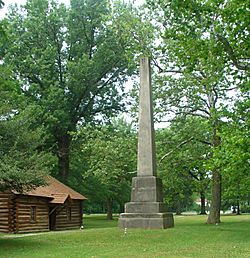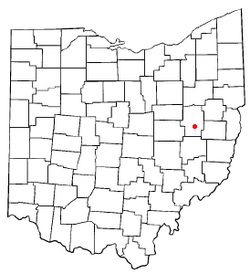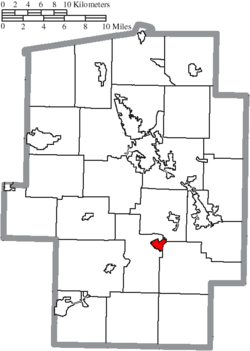Gnadenhutten, Ohio facts for kids
Quick facts for kids
Gnadenhutten, Ohio
|
|
|---|---|
|
Village
|
|

Monument at the massacre site
|
|

Location of Gnadenhutten, Ohio
|
|

Location of Gnadenhutten in Tuscarawas County
|
|
| Country | United States |
| State | Ohio |
| County | Tuscarawas |
| Townships | Clay, Warwick, & Rush |
| Area | |
| • Total | 0.92 sq mi (2.37 km2) |
| • Land | 0.92 sq mi (2.37 km2) |
| • Water | 0.00 sq mi (0.00 km2) |
| Elevation | 846 ft (258 m) |
| Population
(2020)
|
|
| • Total | 1,240 |
| • Estimate
(2023)
|
1,209 |
| • Density | 1,353.71/sq mi (522.82/km2) |
| Time zone | UTC-5 (Eastern (EST)) |
| • Summer (DST) | UTC-4 (EDT) |
| ZIP code |
44629
|
| Area code(s) | 740, 330 |
| FIPS code | 39-30702 |
| GNIS feature ID | 2398983 |
Gnadenhutten is a small village in Tuscarawas County, Ohio, United States. Its name means "Huts of Grace" in German. In 2020, about 1,240 people lived there.
Gnadenhutten is special because it's the oldest settlement still existing in Ohio. It was started in 1772 by Moravian Christians. It is also known as the place where the Gnadenhutten massacre happened during the American Revolutionary War.
Contents
What's in a Name?
The name Gnadenhutten comes from the German word Gnadenhütten. This means "huts of grace" or "mercy huts." It can also mean "log tabernacle," which is like a simple church made of logs.
Reader's Digest magazine once said that Gnadenhutten was the "most difficult to pronounce" place name in Ohio!
Village History
Gnadenhutten was first settled in October 1772. It was the second village created by German Americans and Lenape Indians who were part of the Moravian Church. Another nearby settlement, Schoenbrunn, was founded a few months earlier.
These communities were home to Christian Lenni Lenape people. By 1775, Gnadenhutten had grown to about 200 residents. On July 4, 1773, the first known white child in Ohio was born here.
The American Revolution and Neutrality
During the American Revolution, the people of Gnadenhutten were pacifists. This means they believed in peace and did not want to fight. They tried to stay neutral, meaning they didn't pick a side in the war.
However, the British and their Native American allies, like the Wyandot and Delaware tribes, thought the Christian communities were helping the American patriots. Because of this, the British forced the Lenape people to move to the Upper Sandusky area in Ohio.
The Gnadenhutten Massacre
While many Lenape were away, about 150 were allowed to return to Gnadenhutten. They wanted to gather their harvest and supplies. But in March 1782, Pennsylvania militiamen arrived. These soldiers were led by David Williamson. They were angry because other Native American tribes had recently attacked American settlers.
The militiamen tricked the Lenape people into giving up their weapons. On the night of March 7, 1782, 96 innocent Lenape men, women, and children spent their last hours in prayer. The next morning, March 8, 1782, the Pennsylvanians killed them. This terrible event is known as the Gnadenhutten massacre. The soldiers then burned the village's 60 cabins. Only two boys managed to escape. This event caused a lot of distrust between Native Americans and American settlers.
After the Massacre
After the massacre, the area was opened for European American settlers. John Heckewelder built the first new house in 1798. Moravian people still live in Gnadenhutten today. Few Native Americans chose to return.
Gnadenhutten was an important stop on a major wagon road. Later, the first Ohio Canal was built nearby between 1825 and 1830. This helped people travel and trade goods. A railroad came to the area in 1853, which also helped with trade and industry. A big flood in 1915 destroyed the canal, but by then, other ways of transportation were more common.
Remembering the Past
Gnadenhutten has a monument to remember the people who died in the 1782 massacre. It was built during the village's 100th anniversary. In 1963, a museum was opened to share the town's history. The museum has rebuilt the Mission House and Cooper shop. It also has a mound where the victims are buried.
In 1988, Native American and First Nations people gathered at the site to plant a peace tree. The State of Ohio put up a memorial marker in 2003, calling the massacre a "day of shame."
The Moravian church was rebuilt in 1903. It was dedicated to John Heckewelder, an early settler. The village also has other churches and a library built in 1942.
Village Geography
Gnadenhutten is a small village. The United States Census Bureau says it covers about 0.97 square miles (2.37 square kilometers) of land.
Population Information
Gnadenhutten has had a changing population over the years. Here's how the number of people living there has changed:
| Historical population | |||
|---|---|---|---|
| Census | Pop. | %± | |
| 1870 | 284 | — | |
| 1880 | 336 | 18.3% | |
| 1890 | 478 | 42.3% | |
| 1900 | 547 | 14.4% | |
| 1910 | 560 | 2.4% | |
| 1920 | 530 | −5.4% | |
| 1930 | 870 | 64.2% | |
| 1940 | 876 | 0.7% | |
| 1950 | 895 | 2.2% | |
| 1960 | 1,257 | 40.4% | |
| 1970 | 1,466 | 16.6% | |
| 1980 | 1,320 | −10.0% | |
| 1990 | 1,226 | −7.1% | |
| 2000 | 1,280 | 4.4% | |
| 2010 | 1,288 | 0.6% | |
| 2020 | 1,240 | −3.7% | |
| 2023 (est.) | 1,209 | −6.1% | |
| U.S. Decennial Census | |||
In 2010, there were 1,288 people living in Gnadenhutten. Most residents were white. About 25.6% of the people were under 18 years old. The average age in the village was about 39 years old.
Local Culture and Events
Gnadenhutten is known for its fun Fourth of July celebration. It includes horse-drawn carriages and fireworks. The village also celebrates "Pioneer Days" in early August. An "Apple Butter festival" takes place in October.
The village remembers its Native American past with an "Indian Valley" nickname. There's also a "Christian Indian Christmas Drive-Thru Display" during the holiday season.
Education for Students
Children in Gnadenhutten go to schools in the Indian Valley Local School District. The schools that serve the village are:
- Port Washington Elementary School – for grades K-5
- Midvale Elementary School – also for grades K-5
- Indian Valley Middle School – for grades 6-8
- Indian Valley High School – for grades 9-12
Famous People from Gnadenhutten
- Bob Huggins, a well-known former college basketball coach.
- Eldon Miller, another former college basketball coach.
See also
 In Spanish: Gnadenhutten (Ohio) para niños
In Spanish: Gnadenhutten (Ohio) para niños

